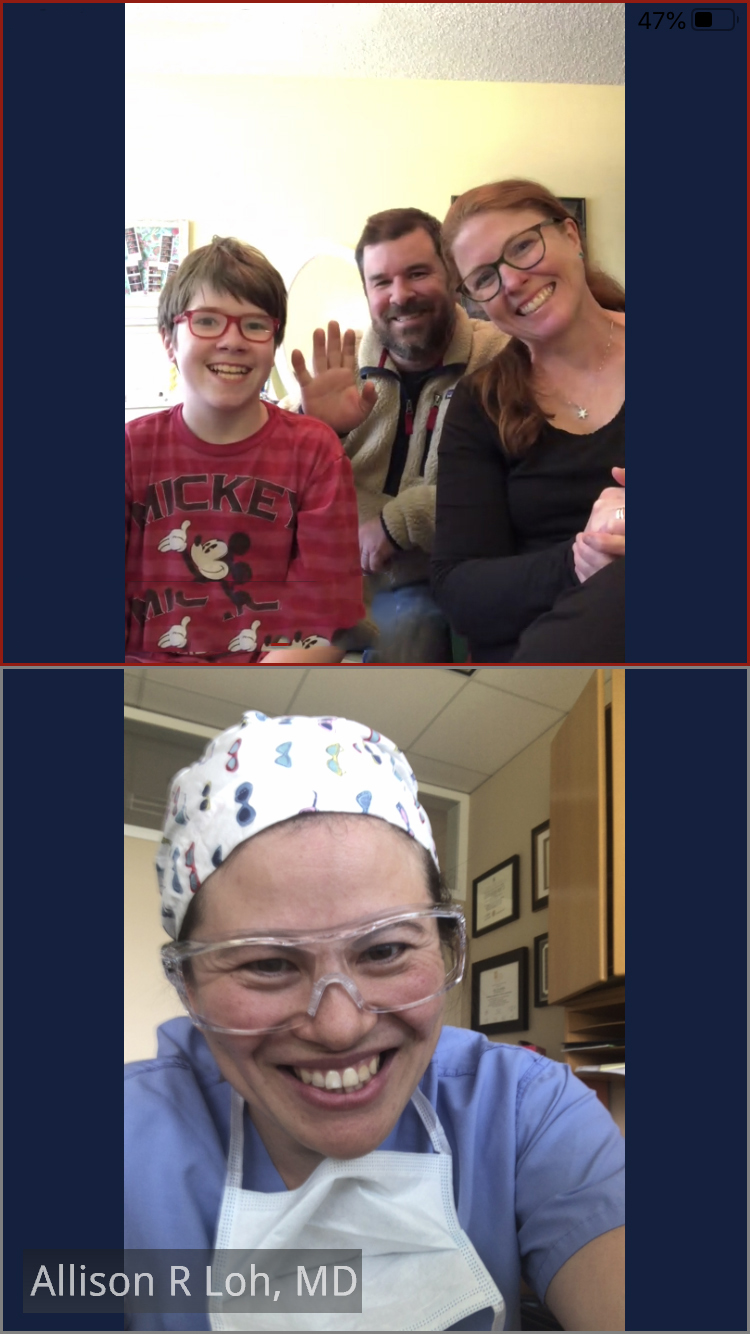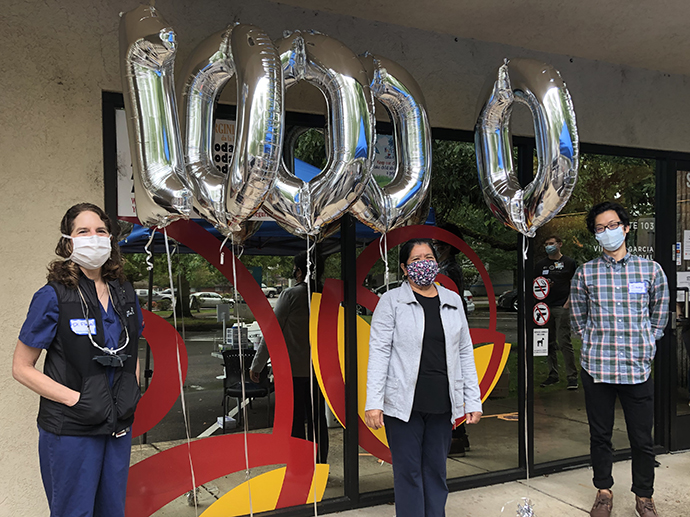
Clinical Care
“Ginger Rogers said, she did everything Fred Astaire did, just backward and in high heels. I think that is the way it felt providing essential eye care services during the pandemic.”
What has the pandemic meant for the delivery of eye care? At first blush, one might think, not much change, as SARS-CoV-2 does not have much effect on the eye. But, when you think of the risk factors for getting COVID – older age, crowded indoor environments, diabetes, other immunocompromising diseases - you have an accurate description of the waiting area for most eye clinics. On top of that, eye exams are conducted in a closed room, with patients and physicians close together for prolonged periods.
This year required us to quickly adopt precautions, enabling us to provide eye care in a safe and timely manner. To provide this essential care required communication, teamwork, innovation and prioritization.
Dr. Allison Loh and other Casey Eye Institute pediatric ophthalmologists devised a web conferencing platform to examine children. It is hard enough examining a young child in person, but remarkably, during the peak of the pandemic, Dr. Loh was able to see 56% of her patients via Webex, and maintained her clinic at 60% of its’ usual volume.
In addition, ocular oncologist Dr. Alison Skalet devised guidelines that were adopted nationally to prioritize the care of patients with eye cancer.
The glaucoma clinic pivoted to a hybrid model, utilizing advanced imaging to accomplish close monitoring of patients, adding a physician call or appointment as needed. This innovative way to care for patients is something we expect to continue to do going forward.
However, we still need to be in the same room with the patient to do surgery. During the past year, we performed 280 retinal detachment repairs, 48 open globe repairs, 183 corneal transplants, 34 orbital tumor removals, and 380 glaucoma procedures. Clearly, severe, acute eye disease did not go into quarantine during the pandemic. As patients and providers, we give a “tip of the hat” to Dr. David Larsen, Bella Almario, Amanda Amling, Dr. Andy Lauer and all of the operating room staff for their enormous commitment to keeping the OR functioning in a safe and timely fashion. This was perhaps the most essential and challenging of tasks, and we are very grateful.
Many of these innovations will carry forward in our post pandemic clinics. We are not there yet, but it is easy to see how some of the efficiency and patient safety innovations of the pandemic will improve our care into the future.
Research
The COVID pandemic posed particular challenges for research activities. Modified operations meant that on-site laboratory functions needed to be reduced to the bare essentials. However, with the restrictions came opportunities in the form of time to work on publications and grant applications.
In fact, the Casey faculty had a remarkable year as shown by the list of selected publications listed in this edition of FY Eye (the list included represents only about half of the total number of publications by Casey faculty). In addition to these noteworthy publications, Casey investigators were successful in securing or renewing the following grant awards:
New:
Yali Jia and John Morrison, NIH/NEI, R01 EY028755, Visible-Light OCT Angiography, Velocimetry, and Oximetry for Characterizing Retinal Vascular Alterations in Glaucoma
Yali Jia, BrightFocus Foundation, Cellular-Resolution Visible-Light OCT for Early Identification of Glaucomatous Neurodegeneration
Yifan Jian, Research to Prevent Blindness Career Advancement Award, Functional Imaging with a Practical Implementation of Ultrahigh-Speed Line-Field Optical Coherence Tomography
Shaohua PI, Knights Templar Eye Foundation, Imaging Retinal Vascular Pathologies in Retinopathy of Prematurity with Visible-Light Optical Coherence Tomography
Phoebe Lin, NIH/NEI, R01 EY032882, Intestinal T Cells and Microbiota as Therapeutic Targets in Autoimmune Uveitis
Renewals:
David Huang, NIH/NEI, R01 EY023285, Functional and Structural Optical Coherence Tomography for Glaucoma
Kate Keller, NIH/NEI, R01 EY019643, Extracellular Matrix and Outflow Resistance
Additionally, Casey’s Associate Director, David Huang, M.D. Ph.D. was one of 13 scientists and doctors worldwide recognized with the Greenberg Prize to End Blindness for his role in the invention of optical coherence tomography – an imaging technology widely used to diagnose and monitor eye diseases.
The “good” viruses
The ”bad” virus causing the COVID pandemic has partially overshadowed the “good” viruses used to treat a growing number of patients with gene therapy. Remarkably, during the year of the pandemic, the ophthalmic genetics group has treated 16 patients, 21 eyes total, for a variety of inherited eye conditions, bringing new hope to patients who had no options to prevent their worsening vision loss. The life-changing impact of these new therapies is captured in a quote from JoDee Hambright, who received treatment for Lebers Congenital Amaurosis, the condition for which there is now an FDA-approved therapy.
“Every day I am amazed at the miracle of science. It has been an amazing year experiencing all the visual changes as a result of the gene therapy — my night vision has improved drastically. I was able to see stars with my naked eye for the first time. I’m able to read things I have not been able to since I was a kid. I am eternally grateful to Dr. Pennesi and the team at the Casey Eye Institute for this incredible gift,” Hambright said.
We look forward to the restoration of full operations of our research activities; but in the meantime, we salute the amazing accomplishments of the CEI faculty during the pandemic.
Community Outreach

The mission of our community outreach program is to reach domestic and foreign communities that have limited access to eye care. This difficult mission was further imperiled by the additional challenges of the pandemic.
Yet our domestic program of outreach is arguably stronger and more ambitious than ever. How is that possible? Credit goes to the passion of those working in and supporting the program. As soon as prohibitions were lifted, Verian Wedeking and his team on the Outreach Van designed a program that permitted safe and effective screening in conjunction with our community partners. The screening van also proved a useful adjunct for outreach associated with relief to populations suffering displacement by the summer wildfires.
The importance of domestic outreach was never more evident than during the pandemic. Thanks to The Roundhouse Foundation, implementation of alternative systems to deliver eye care will be a lasting legacy of 2020. This Foundation recently committed to fund an ambitious expansion of the outreach program to train and equip community health workers throughout Oregon, creating a high-tech screening network to assist in the elimination of preventable blindness. Heather Killough, who consistently supports this program reinforced her support with funding for a second screening vehicle. As Verian says “Go Casey go”.
The worldwide travel restrictions and political events in Myanmar create even greater challenges for our global outreach programs. When we see news of the events in Myanmar, those of us who have been to Myanmar remember peering out the window of a monk driven van, bumping along a one-lane road outside of Mandalay, seeing road crews melting tar in oil drums, painstakingly paving segments of the highway by manual labor. When we see our Myanmar colleagues’ names appear on Zoom or Webex conferences, we remember scurrying up the embankment of the Irrawaddy River, assisted by frail five-year-old children, hoping to augment their meager family income with a tip for their efforts.
Nevertheless, even as we see these challenges, we see progress, and that the programs we support continue. The team of ophthalmologists who received advanced training from the Casey Eye Institute continue to care for their patients, shifting their workplaces from now closed government hospitals to charity hospitals, where they provide free care to patients. Preparation for a broad-reaching child eye health screening in the Irrawaddy river valley continues, as the pediatric vision health technicians and doctors pursue coursework and planning work, in anticipation of launching this program later this year. The Myanmar ophthalmologists are amazingly committed, and with our established relationship we can assist them remotely. Current circumstances reinforce our goal of assisting with and learning from the implementation of screening and public health programs in this country in which 10% of the population is blind.